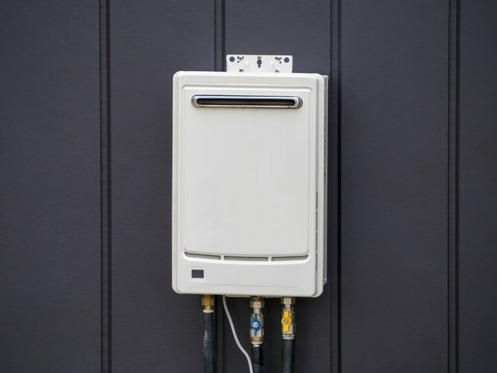If you live in the Denver Metro area, owning a tankless water heater is a great way to practice sustainability at home. Like a traditional tank water heater, flushing your tankless water heater is an important part of routine maintenance. The High 5 Plumbing, Heating, Cooling, and Electric team has some insight to show you when and how to flush your tankless water heater for maximum performance.
Why Flushing Is Necessary
So, do tankless water heaters need to be flushed? Just like “regular” tank water heaters, flushing is an important element of good maintenance. Here’s why flushing this type of water heater is necessary:
- Reduces mineral buildup: If you have hard water that contains minerals like calcium and magnesium, flushing your tankless water heater removes that excess buildup to help the unit maintain maximum efficiency.
- Improves efficiency: Cleaning a tankless water heater by flushing it removes blockages that can make it more difficult for hot water to flow. It also helps the heat transfer more efficiently, resulting in faster heating times and better energy efficiency overall.
- Prevents clogs: Flushing removes mineral deposits and other buildup from your tankless water heater that could cause a blockage, noise, and lower water pressure.
- Prolongs unit lifespan: Routine flushing prevents corrosion and damage to the heat exchanger, extending the lifespan of your tankless water heater.
- Reduces noise: Over time, buildup can make the water heater run noisily, while flushing it maintains a much quieter operation.
- Saves you money: Regular flushing will reduce monthly energy costs and prevent costly breakdowns.
- Keeps warranty valid: Many major tankless water heater manufacturers require owners to flush the unit annually to keep the warranty coverage valid and active.
When to Flush a Tankless Water Heater
When it comes to how often to flush a tankless water heater, you should try to flush it at least once a year. If you have hard water, flushing every six to nine months is best.
Here are some other instances when you may need to flush your tankless water heater more often than once a year:
- Drop in water pressure: Buildup can restrict water flow and create lower pressure, but flushing should relieve the issue.
- Takes longer for hot water: If your unit is clogged, it may take a lot longer for the water to reach your desired temperature.
- No hot water: If the unit is severely clogged, you may not get any hot water until you flush it.
- Odd noises: When the water heater is running, you may notice loud or unusual noises, which could indicate excessive mineral buildup or erosion.
- High energy bills: A sudden and unexpected increase in your energy bills might be due to reduced efficiency caused by scale or mineral buildup in your tankless water heater.
Steps to Flush a Tankless Water Heater
Follow these steps to flush your tankless water heater in the Denver Metro area:
- Step one: Turn off the power at the circuit breaker. If you have a gas tankless water heater, turn off the gas valve and close the isolation valves or shut-off valves, if applicable, before proceeding to the next step.
- Step two: Look for the drain valve or purge port valve on the water heater. Attach a hose to the drain valve, placing the other end in a bucket to collect the drained water.
- Step three: Open the drain valve and let the water inside the tankless heater drain into the bucket.
- Step four: Remove the prefilter (usually located at the bottom) and clean it to remove sediment and buildup using a store-bought descaling agent or some white vinegar.
- Step five: Fill a bucket with descaling solution, attach the pump to the bucket containing the solution, and connect the hoses to the water heater’s service valves.
- Step six: Turn on the pump and let the descaling solution circulate through the unit for between 30 and 60 minutes, then turn the pump off when cleaning is complete.
- Step seven: Turn on the cold water supply valve, rinse the system thoroughly, and turn it off once the water runs clear.
- Step eight: Disconnect the hoses from the service valves and remove the pump, then reconnect the isolation valves and drain valve caps.
- Step nine: Turn on the power and gas (if applicable), and inspect connections and valves for leaks.
Troubleshooting Tips
If you’re having an issue with your tankless water heater, try these helpful troubleshooting tips:
- Ensure the circuit breaker hasn’t tripped, your water heater receives power, the gas valve is open, and the pilot light is lit.
- Check to ensure sufficient water flows through the heater and inspect the inlet water filter for clogs.
- If you have a gas tankless water heater, inspect the vents and air intake for blockages and make sure the burners are clean.
- Most newer tankless water heaters have a design that displays error codes, so check for any codes that may be displayed on the unit and check the manual to determine what the codes mean.
- De-scale and flush your water heater if you notice a drop in efficiency, water pressure, or other issues.
- When in doubt, call the professionals at High 5 to help troubleshoot, diagnose, and repair the issue.
Need Help With a Tankless Water Heater? Contact the Team of Plumbers at High 5 Today!
High 5 offers comprehensive, expert plumbing services that focus on what’s needed and the most effective way to do the job. True to our core values, our plumbing company is upfront about pricing, and our prices are affordable. We work hard to earn our customers’ trust and satisfaction in the Denver Metro area. If you need help with your tankless water heater and want to schedule service, contact us today!

